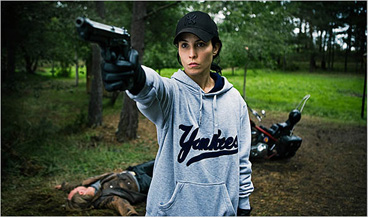Chapter Two: The Girl Who Played With Fire
By Brett Beach
February 3, 2011
Those ramifications are what drive The Girl Who Played with Fire. As the film opens, it is nearly two years after Dragon Tattoo took place and it seems as if Mikael and Lisbeth will never see each other again. He has been vindicated in the libel suit brought against him by the subject of a scathing expose, and she has been globetrotting with ill-gotten gains. But then, as his magazine is on the verge of publishing a new series about sex trafficking that threatens to implicate major players in Swedish law enforcement and the judicial system, Mikael is stunned when the author of the piece, his girlfriend, and Lisbeth’s former legal guardian are found murdered, execution style, with Lisbeth’s prints on the gun. Knowing she is innocent, Mikael sets out to prove it, while a cover-up is already under way to frame the two (or just murder them, whatever is more convenient at any given moment.)
The original Swedish title of Larsson’s first book translates roughly as Men Who Hate Women, and though it is especially relevant there, that phrase could accurately serve as the title for any one of them. An even more apt title would be Geriatric Ailing Men Who Hate Women, since the villains in each installment have been around for so long they are now into their late 60s and early 70s, attempting to hold on to the power structure they have grown accustomed to, flinching like moles when their world is held up to the light of day.
They are also quite willing to resort to violence themselves, and the movies do a good job of highlighting the irony of this wheezing status quo orchestrating murders in between dialysis treatments. The quote at the start of the column comes from a minor character (it may in fact be his only line), but it sums up the worldview of many males in Larsson’s oeuvre, who can’t see women as equals, and in many cases see them as less than human.
This epitomizes the inherent tension in Larsson’s work: As a journalist in real life, he was also outraged at violence against women and was an advocate against it. Lisbeth Salander is a heroine who reflects that belief in her actions and manners. She needs no one, takes care of herself, can defend herself in tight situations, refuses to apologize for her actions, and will brand an attacker with an incriminating phrase across his stomach.
She also suffers horribly, in quite explicit detail, and at great length. I can only imagine at this point how scenes like her rape play on the page. As much as she is allowed to retain her edge — with few concessions to make her more likable — there is also a subtle softening of her character in the second and third films. When first glimpsed abroad and on the run as The Girl Who Played with Fire opens, she is uncharacteristically disguised in a dress and blond wig. When a kindly doctor sneaks in a pizza for her in The Girl Who Kicked the Hornet’s Nest, she almost cracks a slight smile to herself. By virtue of being in the hospital and then prison for much of the third film, she becomes more acted upon than force of nature.
Continued:
1
2
3
4
5
|
|
|
|




